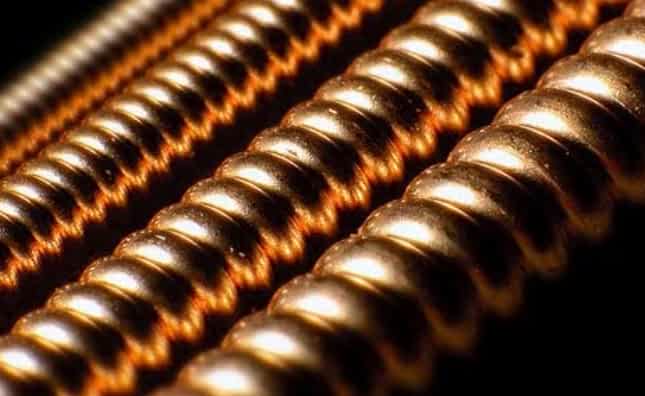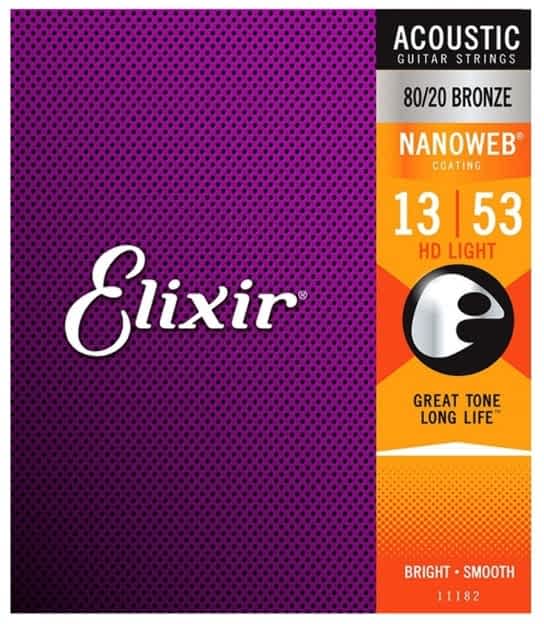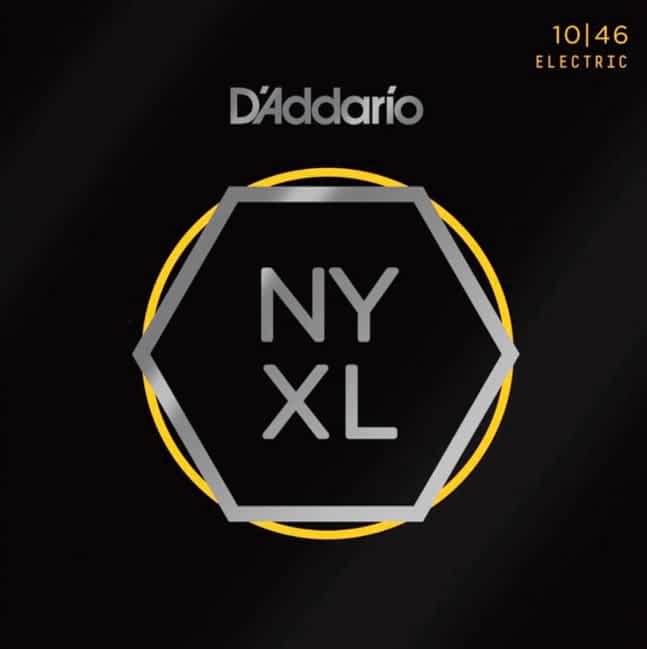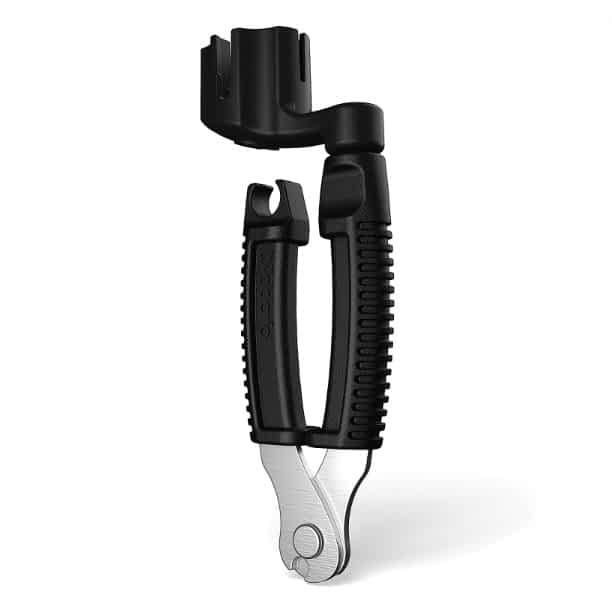Best
Acoustic Guitar String
-
Overall: Featuring maraging steel hex-core wire
-
Best Feature: Wrap wire made from a blend of copper and aluminium
-
TedScore™: 8/10
Best
Electric Guitar String
1046 BEST STRINGS OFFERING TUNING STABILITY AND SNAPPING RESISTANCE
-
Overall: Rhythm Guitar Players
-
Best Feature: The strings preserve your finger stamina
-
TedScore™: 9/10
Best
Accessory for Guitars
-
Overall: All guitars, banjos & mandolins
-
Best Feature: With integrated bridge pin puller for acoustic instruments
-
TedScore™: 10/10
Are you stuck in the never-ending argument about electric strings vs acoustic?
Choosing the right guitar strings can make a big difference in your sound and playing ease. Acoustic guitar strings usually have brass or bronze coatings, giving a rich, warm tone perfect for sounding through a wooden soundhole.
On the other hand, electric guitar strings use steel or nickel and are made to work with magnetic pickups, creating that classic electric guitar sound. The choice of material and coating changes everything from tone to how easy it is to play.
Whether strumming a sweet acoustic ballad or shredding an electric solo, understanding the differences can improve your music journey. Jump in to explore how the right strings can improve your guitar playing!
Is It Okay to Interchange Guitar Strings?
It’s not recommended to interchange electric guitar strings on acoustic due to the significant tension difference. Use the wrong string, and you can damage the guitar’s neck, bridge, and soundboard.
However, if you want to try electric strings on an acoustic guitar to create a unique sound, you should use heavier gauge strings to compensate for the increased tension.
It’s also worth noting that steel strings are not the only strings used on acoustic guitars.
Acoustic Guitar Strings
Acoustic guitar strings come in different sizes and shapes, with varying types of materials, making them suitable for Concert, Grand Concert, Auditorium, Grand Auditorium, and Dreadnought.
They’re made from steel or similarly durable and long-lasting materials.
These strings are usually thicker and larger, giving them a warmer and brighter sound that is perfect for playing in a large room or during a performance.
Acoustic guitar strings require a lighter touch and vibrate more due to their larger gauge and heavier build.
Construction and Materials
Acoustic guitar strings are made from various materials, such as bronze alloys, phosphor bronze, brass, or nickel bronze. These materials are chosen for their warm, bright, and clear sound.
In contrast, electric guitar strings are usually made of steel or nickel, which produces a more brilliant and sustained sound.

Additionally, classical guitar strings are typically made of nylon and bronze for the lower lines.
Tension and Gauge
Tension and gauge are essential factors to consider. Acoustic strings typically require higher tension than electric guitar strings and are typically measured in pounds per linear inch of pressure.
The standard factory string gauge for acoustic guitars is usually around 12, while electric guitars generally use .009 or .010-gauge strings.

However, acoustic string gauges can range from 9-gauge to 13-gauge to suit different playing styles and scale lengths. The tension and gauge of your guitar strings will greatly impact your playing experience, so choose the right strings to match your playing style and preferences.
Playing Style and Technique
In terms of playing technique, the most common approach is to use a pick, also known as a plectrum, to strike the strings. This produces a bright, percussive sound for strumming chords and playing lead lines.
Fingerstyle playing is often used in folk and classical music and can involve various techniques, such as fingerpicking, thumb picking, and hybrid picking.
Top 3 Acoustic Guitar Strings
Ernie Ball Aluminum Bronze Acoustic Guitar Strings
Ernie Ball Aluminum Bronze Acoustic Guitar Strings

FEATURES: Featuring maraging steel hex-core wire
OTHER INFO: Wrap wire made from a blend of copper and aluminium
- Patented technology
- Richer and fuller tone with powerful low-end response
- With brighter sounds
- Can be too bright sounding at times
When you click ‘Check Price’, you’ll see there are loads of great places to buy this item. Our personal favorite is Sweetwater for the US, and Thomann and Gear4Music for the UK & Europe.
They are the largest music retailers, with excellent customer service, competitive prices, really fast shipping, and the longest guarantees.
The professional musician who wrote this article combined many things,
from the product build, manufacturer’s reputation through to feedback
from other users, to create our famous TedScore™.
Ernie Ball Aluminum Bronze Acoustic Guitar Strings offer a distinct, bright tone with excellent projection and clarity. These strings are made from a blend of copper and aluminum wrapped around a hex-shaped steel core, providing improved durability and resistance to corrosion.
D'Addario EJ17-3D Acoustic Guitar Strings
D'Addario EJ17-3D Acoustic Guitar Strings

FEATURES: Durable phosphor bronze coated string, that keeps their well-balanced and warm tone for a long time
OTHER INFO: String Gauges: Medium - 0.13 to 0.56
- Durable medium strings
- Corrosion-free
- High-quality strings
- The strings have a longer length, and you need to cut them after assembling
When you click ‘Check Price’, you’ll see there are loads of great places to buy this item. Our personal favorite is Sweetwater for the US, and Thomann and Gear4Music for the UK & Europe.
They are the largest music retailers, with excellent customer service, competitive prices, really fast shipping, and the longest guarantees.
The professional musician who wrote this article combined many things,
from the product build, manufacturer’s reputation through to feedback
from other users, to create our famous TedScore™.
EJ17-3D Acoustic Guitar Strings are part of D’Addario’s popular Phosphor Bronze series, offering a warm, rich tone with excellent clarity and projection. These strings feature a hexagonal core made from high-carbon steel, wrapped with precision-wound phosphor bronze wire for enhanced durability and corrosion resistance.
Elixir Strings 80/20 Nanoweb Coated Strings
Elixir Strings 80/20 Nanoweb Coated Strings

FEATURES: Nanoweb-coated strings - clear treble sounds and last for a long time; phosphor bronze material
OTHER INFO: Medium - 0.13-0.56
- A warm and vibrant tone
- Corrosion resistant
- Long-lasting
- A bit pricey
When you click ‘Check Price’, you’ll see there are loads of great places to buy this item. Our personal favorite is Sweetwater for the US, and Thomann and Gear4Music for the UK & Europe.
They are the largest music retailers, with excellent customer service, competitive prices, really fast shipping, and the longest guarantees.
The professional musician who wrote this article combined many things,
from the product build, manufacturer’s reputation through to feedback
from other users, to create our famous TedScore™.
Elixir Strings 80/20 Nanoweb Coated Strings are designed to provide a bright, crisp tone with extended durability and reduced finger squeaks. These strings feature a high-quality 80/20 bronze wrap wire combined with Elixir’s ultra-thin Nanoweb coating, which protects the strings from corrosion and debris buildup without compromising the natural feel and sound.
Electric Guitar Strings
These strings are designed to produce a louder, brighter sound that complements the guitar’s amplified tone.
Construction and Materials
TENSION AND GAUGE
Tone and Sound
PLAYING STYLE AND TECHNIQUE
Top 3 Electric Guitar Strings
Best string for Warm And Resonant Tone
ERNIE BALL 2223 SUPER SLINKY

FEATURES: These Nickel Steel Strings Offer A Warm And Resonant Tone Even When The Guitar Is Not Plugged Into An Amp
OTHER INFO: STRING GAUGES: 0.09-0.42
- Clarity throughout the entire fretboard
- Highly versatile
- The nickel plated steel strings sound great without an amp
- Not the best option for guitarists who like a dark tone
When you click ‘Check Price’, you’ll see there are loads of great places to buy this item. Our personal favorite is Sweetwater for the US, and Thomann and Gear4Music for the UK & Europe.
They are the largest music retailers, with excellent customer service, competitive prices, really fast shipping, and the longest guarantees.
The professional musician who wrote this article combined many things,
from the product build, manufacturer’s reputation through to feedback
from other users, to create our famous TedScore™.
The ERNIE BALL 2223 SUPER SLINKY guitar strings provide a smooth, effortless playing experience with a bright and balanced tone that enhances any performance. Their durability and consistent quality make them a top choice for both amateur and professional guitarists.
Best string for drop tunings
D’ADDARIO EXL 110-3D

FEATURES: Thick Strings Perfect For Frequent Tuning Changes
OTHER INFO: STRING GAUGES: 0.10-0.46
- Durable
- Best for drop tunings
- High-end performance
- Some beginners find the thicker gauge uncomfortable
When you click ‘Check Price’, you’ll see there are loads of great places to buy this item. Our personal favorite is Sweetwater for the US, and Thomann and Gear4Music for the UK & Europe.
They are the largest music retailers, with excellent customer service, competitive prices, really fast shipping, and the longest guarantees.
The professional musician who wrote this article combined many things,
from the product build, manufacturer’s reputation through to feedback
from other users, to create our famous TedScore™.
The D’ADDARIO EXL 110-3D guitar strings deliver a reliable, well-rounded tone with excellent intonation and durability. Their consistent performance and versatility make them a go-to option for a wide range of musical styles.
Best string for warm sounds
D’ADDARIO NYXL 1046

FEATURES: High-Carbon nickel-plated steel strings; Resistant To Breaking; Offer Particularly Warm Sounds In The Middle Of The Fretboard
OTHER INFO: STRING GAUGES: 0.10-0.46
- Great for power chords and chords
- The strings preserve your finger stamina
- Long lasting
- Not the best option for solo players
When you click ‘Check Price’, you’ll see there are loads of great places to buy this item. Our personal favorite is Sweetwater for the US, and Thomann and Gear4Music for the UK & Europe.
They are the largest music retailers, with excellent customer service, competitive prices, really fast shipping, and the longest guarantees.
The professional musician who wrote this article combined many things,
from the product build, manufacturer’s reputation through to feedback
from other users, to create our famous TedScore™.
The D’ADDARIO NYXL 1046 guitar strings offer remarkable strength and tuning stability, allowing for aggressive playing without frequent retuning. Their enhanced mid-range frequency response and long-lasting durability make them a standout choice for discerning musicians.
How to Care for Your Guitar Strings
Caring for your guitar strings is essential to maintaining sound quality and prolonging their lifespan:
Step 1: Keep Your Hands Clean
Be sure to wash your hands before playing your guitar to remove dirt and natural oils that can cause corrosion and dead strings. Also, clean your fretboard regularly to prevent buildup and protect against dead strings.
Step 2: Wipe Your Strings
After each playing session, wipe your guitar strings with a soft microfiber cleaning cloth to remove moisture and grime.
Step 3: Use a String Cleaner
Investing in a good string cleaner can help prolong the life of your strings by removing buildup and preventing rust.
Step 4: Change Strings Often
Even with regular care, strings eventually wear out and lose their sound. Change your strings every few months to keep your sound fresh and bright.
Tools for Your Guitar
When it comes to guitars, there are many tools and accessories available to enhance your playing experience.
Electric guitars are easier to adjust with screws or hex keys on or near the bridge, whereas acoustic guitars require a more complicated setup.
Regardless of what type of guitar you play, changing guitar strings regularly is essential for keeping the sound quality top-notch.
Guitar String Winder/Cutter
This handy tool makes replacing strings on your guitar easier and faster, ensuring you can always have fresh lines ready.
When it comes to acoustic vs electric guitar strings, there are some notable differences. For example, G strings on acoustic guitars are usually all wound strings, whereas G strings are generally unwound on electric guitars.
When changing strings, it’s also important to check the nut and bridge saddle for binding and adjust the truss rod for correct tension.
The string winder we recommend is the D’Addario Pro-Winder:
D'Addario Guitar Pro-Winder String Winder/Cutter

FEATURES: With integrated bridge pin puller for acoustic instruments
OTHER INFO: Designed for efficient and comfortable use
- Comes with a built-in string cutter
- Specifically designed to cut bass or guitar strings
- Can cut strings even at sizes above 3mm
- None!
When you click ‘Check Price’, you’ll see there are loads of great places to buy this item. Our personal favorite is Sweetwater for the US, and Thomann and Gear4Music for the UK & Europe.
They are the largest music retailers, with excellent customer service, competitive prices, really fast shipping, and the longest guarantees.
The professional musician who wrote this article combined many things,
from the product build, manufacturer’s reputation through to feedback
from other users, to create our famous TedScore™.
The D’Addario Guitar Pro-Winder String Winder/Cutter is a versatile tool that simplifies string changes with its integrated winder, cutter, and bridge pin puller. Its ergonomic design and durable construction make it an essential accessory for any guitarist.
Acoustic vs Electric Guitar Strings
Summary
When I compare the difference between acoustic and electric guitar string, the materials and design stand out.
Materials:
- Acoustic: Typically made from brass or bronze, enhancing resonance.
- Electric: Usually steel or nickel for magnetic properties.
Tone:
- Acoustic: Richer, more resonant sounds.
- Electric: Brighter tones, ideal for rock or metal.
Customization:
- Acoustic guitars offer various string types, pickups, and accessories like capos.
- Electric guitars support various customization options, including pickups, pedals, and amps.
String Gauges:
- Acoustic: Usually have heavier gauges.
- Electric: Generally lighter, easier to play.
In conclusion, you really don’t want to interchange guitar strings between acoustic and electric guitars. They are made differently and for good reason.
Each type of guitar string has its strengths. Experimenting with different strings can enhance your playing experience.
If you want to see a good list of guitar strings, take a look at our list of 20 Best Guitar Strings here.
Good luck, and happy strumming!
FAQ's
Although the fretboards on electric and acoustic guitars are the same, their strings differ – meaning the notes and chords can vary. The strings used largely depend on the type of guitar being played. Electric guitars use steel or even nickel plated strings, whereas acoustic guitars use bronze or brass strings. Nylon strings are exclusive to classical guitars.
Yes, using electric guitar strings on an acoustic guitar is possible, but it’s not recommended. The bronze coating used on acoustic guitar strings is a fundamental part of their sound, and electric guitar strings lack this bronze coating. This means that the electric guitar pickups will produce a different sound than usual. However, if you’re curious, you can always try it by experimenting with different types of strings. Steel strings are often used on nylon-string acoustic guitars, popular in classical music. But one thing to note is that electric guitar strings may only produce sound from the first and second strings as these have similarities to electric guitar strings.
Regarding guitar strings, the gauge (thickness) can greatly impact the tone and playability of the instrument. Acoustic guitars typically use thicker strings than electric guitars, with the most common gauge being 12 gauge. On the other hand, electric guitars generally use a lighter gauge, with the standard factory string gauge being about .009 or .010. However, there are many options for electric guitar strings, ranging from 8-gauge to 14-gauge. Common string sets for electric guitars are 9-gauge and 10-gauge, referred to as either ‘super light’, ‘light’, ‘medium’ or ‘heavy’.














good stuff in the article, but does anyone really change their strings that often? i mean, i wait till they practically fall off. haha, maybe that’s why my sound is so ‘unique’.
This article was a fantastic read for someone like me who spends hours tweaking small details for the perfect sound. The discussion on how playing style and technique can influence string choice was particularly enlightening. It’s something I’ll definitely be experimenting with in my studio.
Wow, so you’re telling me strings actually affect tone? Who would’ve thought! Next, you’ll discover that water is wet.
I’ve tried many of the strings mentioned in this article, and none of them live up to the hype. It feels like a lot of what’s recommended is more about brand partnerships than actual performance. Are there any unbiased recommendations out there?
strings? i thought the magic was all in the fingers! next, you’ll tell me the guitar matters too, haha.
oh great, more things to spend money on. just when i thought i had all the guitar gear i needed, this article convinces me i need to try out another set of strings.
Great read on the nuances of guitar strings. What I think would add even more value is if there was a section dedicated to how different environments (humidity, temperature, etc.) can affect string life and performance. Has anyone experienced dramatic changes in their string behavior with the seasons?
I must point out, while the article does a good job covering various string types, it slightly oversimplifies when discussing tone and sound characteristics. As a jazz instructor, I’ve found that the interaction between string materials and the unique woods of a guitar also significantly influences tone.
This is my first time really diving into the details of guitar strings and I found the section on how to care for your guitar strings incredibly helpful. Could someone clarify the frequency of changing strings? The article suggests often, but what does ‘often’ mean in terms of actual time?
Finally, an article that talks about the best strings for drop tunings! Been trying to find the perfect set for my metal setup. The recommendation is spot on.